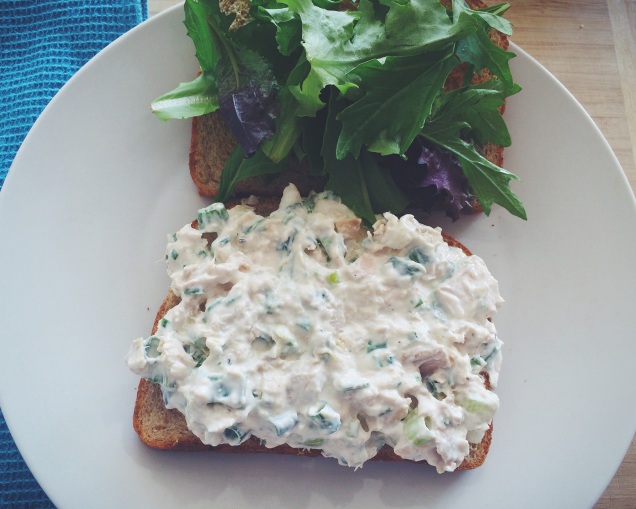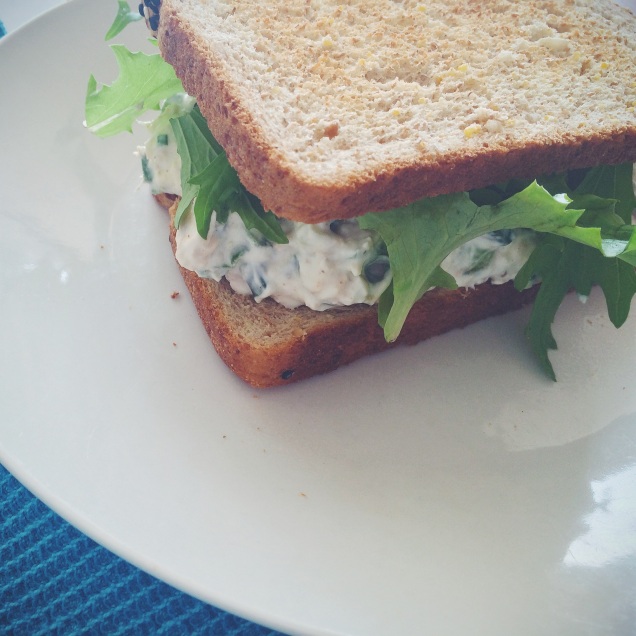It may be a week until Christmas, but I’m already kind of done with the cookies. Maybe it’s because everyone’s Christmas parties start back into the beginning of December, or maybe it’s because I joined some friends in a cookie-baking-bonanza that resulted in a whole tin of cookies to myself. I kind of don’t want at all mashed potatoes or stuffing or ham or holiday comfort food. I’ve been jamming on avocados and goat cheese, and I got into my mind that I could really go for an Asian salad. You know the kind, the Americanized version with ginger and wontons.
Well, of course, I didn’t have the ingredients for the giant salad of my imagination (which mirrored that of California Pizza Kitchen fairly precisely), but I did recognize I had a bunch of kale, a threatening-to-die carrot, and maybe some impromptu dressing ingredients. Out of a basic pantry and sad representation of a refrigerator… I created the best dinner I have had in months.
No, really. Admittedly, I freaking love the dumplings from Trader Joe’s. I used to buy the pork gyoza all the time, but somehow hadn’t in awhile… maybe it was a grad school thing. But I don’t eat pork or pigs anymore, and the frozen isle caught my eye (I’ve been excessively lazy recently). I saw Thai gyoza and thought I’d give it a try. The dumplings, while absolutely important, sit atop a salad so flavorful and balanced, that the whole (giant) bowl just satisfies every salty, tangy, savory craving you didn’t even know you had. I was not at all a believer in kale salads; I usually sauté my kale or put it in soups (read: why I had kale in the first place… soup season). But by massaging in the dressing, the kale becomes perfectly crunchy with just the right bite to offset the soft, fluffy little dumplings. I must say, the fresh ginger makes it. Which I totally would not have had if Thanksgiving had not been so recent, but please buy some if you’re making this salad tomorrow (as you should).
And, so long as you have this, or just a normal bottle of Sriracha, you are totally ready to go.
Thai Dumpling Kale Salad
Serves 1 hungry person (per usual); easily multiplied
Thai Peanut Dressing
½ tbsp. canola (or other mild-flavored) oil
½ tbsp. tamari or soy sauce
1 tsp. natural peanut butter (peanuts and salt)
1 tsp brown sugar
½ tsp. sriracha
2 inch ginger knob, peeled and grated finely, juice included, stringy remnants discarded
Dash crushed red pepper flake
Salad and Dumplings
2 cups organic curly kale, chopped finely
1 golden carrot, peeled and minced/ chopped finely
½ tbsp. canola oil
5 Thai vegetable (or shrimp) gyoza/ dumplings (from Trader Joe’s)
2 tbsp. roasted and salted peanuts
Sriracha to serve
In a large serving bowl, whisk together the dressing ingredients. Add the kale and toss, with your hands, massaging the dressing into the kale leaves. Set aside while you prepare the remaining ingredients (time is your friend).
Use a food processor to finely chop the carrot (or your own determination and knife) and add to the greens. Toss.
In a small, non-stick sauté pan, prepare the gyoza according to package directions, which I’ll include here. Heat the oil over medium high heat and add the gyoza to the pan. Cook for 3-4 minutes until the bottom is browning. Add ¼ cup of water to the pan and quickly cover with a lid. Steam for 4-5 minutes until the gyoza are softened and cooked through.
Sprinkle the peanuts over the top of the salad and place the gyoza on top. Drizzle Sriracha over everything.
Absolutely dig in.
Real question: should this blog be titled “Sriracha to serve”? Seems that’s at the end of every recipe. Also, I hate how dinner time in the winter means it’s pitch black outside. Try taking a good photo in your dark, poorly lit living room… sigh. At least dinner is good.







































